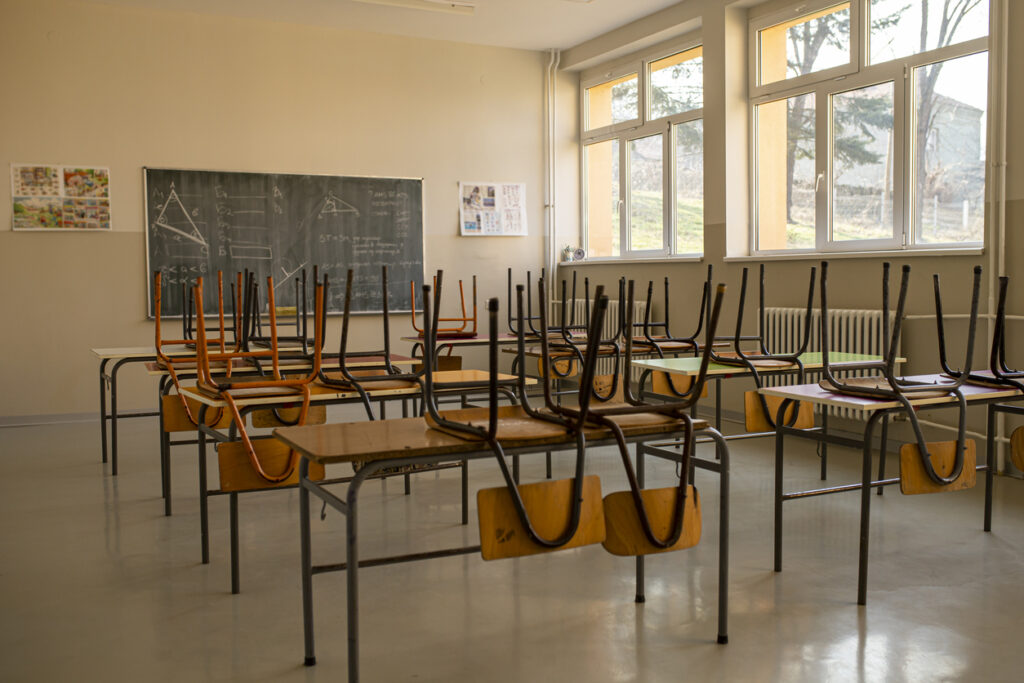Editor’s Note: Today’s piece is by Michael Rodriguez. Michael serves as Senior Strategist for Content and Scholarly Communication Initiatives at Lyrasis, where he advances consortial licensing and open access programs at a national scale.
In the first half of 2024, institutions of higher education in the United States closed permanently at the rate of one per week, according to one estimate, with little sign of slowing down. Where the author lives in Pennsylvania, eight colleges have closed, consolidated, or announced plans to do so since January 2024 alone. These closures directly impact small private colleges and the communities built around them, but closures also ripple throughout the academy, disbanding libraries and archives and endangering access to and preservation of the scholarly record.

Overview of College Closures
In August 2024, the U.S. Department of Education reported that the total number of U.S. higher education institutions had decreased by 2 percent since the previous academic year. According to The Wall Street Journal, more than 500 private, nonprofit colleges have closed in the last ten years, “three times what it was in the decade prior.” Higher Ed Dive lists scores of these colleges that have closed or merged since 2016. Many of these institutions have been concentrated in the Northeast and Midwest, where student enrollment is declining because of population shifts and lower birth rates. However, colleges are shuttering as far apart as Florida and California, in regions that have witnessed sustained population growth in recent decades. Institutions that survived the COVID-19 pandemic have been hit hard by the end of federal relief money. Public confidence in higher education has waned. Institutions have struggled with rising operating costs, overbuilt campuses, and costly deferred maintenance. The federal government has been cracking down on deceptive for-profit colleges, putting many of them out of business.
Private nonprofit institutions at greatest risk of closure tend to fit a profile: small, dependent on tuition revenue, high applicant acceptance rates, already low and declining student enrollment, deeply in debt, located in a region of demographic decline, and often religiously affiliated. Loss of accreditation is of course the death knell for such institutions, but colleges usually risk losing accreditation only when they are already in deep financial trouble or when their leadership is malfeasant. State schools close too, but often in uniquely disastrous circumstances, and they are more likely to shutter campuses or merge into a system than to shut down altogether. (Of course, survival can still mean decline when it comes to college budgets and workforces.)
Impacts of College Closures
When a college closes, the ripple effects are significant. Faculty and staff lose their jobs. Only 17% of students displaced by a college closure go on to earn their degree. As a result, most will earn less money over their lifetimes. Students who transfer to other schools often lose credits, forcing them to invest more time and money to complete their education. Some students have transferred from closing schools only for their new schools to close too. When a college closes, the community simultaneously loses a major employer, a major property owner, a major source of residents and taxes, and a major source of cultural and economic uplift. Campuses may sit empty and decaying for years while owners struggle to sell or repurpose land and buildings. Closures can disrupt the arts and culture of whole cities or leave entire city blocks vacant.
When colleges close, libraries close. Faculty, staff, and students are no longer able to access the library’s resources and expert staff, cutting off a key avenue not only for academic research and education but also for lifelong learning and entrepreneurship in the community. Closures also impact neighboring institutions, whose faculty and students can no longer borrow the library’s materials via interlibrary loan. Community members can no longer benefit from arrangements in which libraries provide onsite-only guest access to paywalled electronic resources.
Implications for Archives and Special Collections
College closures endanger archives and special collections, which contain college records as well as unique materials that document local communities, literary traditions, historical events, and influential people. Intellectual outputs such as some theses and dissertations may be lost to posterity. Both print and digital materials are endangered, as colleges generally pay to maintain repositories that host digital materials, and colleges that close may stop paying those invoices.
Many special collections hold materials of national or international importance. When Finlandia University in Michigan closed in 2023, fear spread that vital sources of Finnish American history and culture would vanish forever into private collections. Fortunately, a Finnish nonprofit raised $3 million to acquire and maintain the collections in a public venue. Unique materials risk being lost to the scholarly record, whether pulped, left to deteriorate in empty buildings, or swept up by private collectors. Institutions might not want their neighbors’ archives, which might be out of scope for their collections or challenging to process and make accessible. Sometimes colleges close too abruptly to make an orderly wind-down possible, especially as libraries and archives are low priorities for administrators or consultants tasked with winding down operations. When the University of the Arts announced its closure with only a week’s notice, staff scrambled to rescue a typewriter exhibit and give away the library collection to other Philadelphia-area libraries. “Otherwise, it will probably be sold off as poundage,” curator Sid Sachs noted.
Implications for Print and Circulating Collections
Libraries’ circulating collections face particularly uncertain futures amid closures. Most libraries hold little in the way of truly unique and/or valuable books or other materials. This is especially true of libraries at small and non-research-intensive institutions, which face the most precarity. Few buyers are interested in print journals, theses, DVDs, or obsolescent formats like microfilm. Print books are likelier to sell, but usually only in bulk and for a pittance. It can be easier just to wait for receivers to dispose of the collection, often by discarding or recycling everything. A few institutions have embraced more innovative solutions. In 2020, leaders at Marygrove College in Detroit donated more than 70,000 books and journals to the Internet Archive, which preserved and digitized the entire collection. Such large donations are uncommon, and colleges that enter receivership may be legally required to keep their assets to pay off their debts — even though Marygrove’s best-case fallback scenario was to sell 32,000 books at the rate of $1 per book. As a preservation strategy, precarious institutions’ library leaders may wish to consider strategic asset dispersals prior to their institutions’ announcing closure or entering bankruptcy.
Loss of circulating collections jeopardizes the purpose of shared print programs. While the types of colleges most liable to close typically do not have large and robust print collections, some are members of shared print programs. The Shared Print Partnership documents Best Practices for Exiting a Shared Print Program, recommending, among other steps, the transfer of ownership of physical materials to other shared print program member libraries, but little concrete guidance or published precedents exist for navigating this process of physically transferring thousands of books and associated metadata. When Holy Names University in Oakland, California, shut down in 2022–23, it had 6,860 shared print retention commitments as part of the SCELC Shared Print Program, 1,791 of which were unique titles held by no other SCELC participating library. Only 94 of these titles ended up at other libraries; the rest went to the Internet Archive. “Nobody was prepared to deal with such a situation,” SCELC Shared Print Committee chair Leanna Goodwater told me. No other shared print program had a system in place to deal with a member’s closure.
Implications for Licensed Resources, Library Consortia, and Vendors
Libraries cancel the last of their licensed electronic resources when their parent institutions close. Thus, closures mean the loss of some subscription dollars for publishers and vendors, but these losses are unlikely to thrust publishers into financial precarity. Closures mostly happen at struggling small schools that have already slashed their libraries’ collection budgets, spreading out the blow to vendors’ bottom lines. Closures may most directly impact revenue at database vendors such as Gale, ProQuest, and EBSCO, as database subscriptions may be among the last resources left standing when small institutions gut their libraries’ collection budgets. (Journal packages and specialized or advanced research resources are often the first to be canceled.)
Digital repository vendors may be left with what are essentially orphaned collections after the holding institutions have closed. Vendors have little contractual duty to preserve content when customers are not paying for this service and when no successors are available to receive the customers’ assets. In general, however, vendors are not contractually obligated to take down or delete content after holding institutions close, unless the rightsholders ask the vendor to do so.
Closures also endanger perpetual access rights to electronic resources. Libraries pay large sums of money to acquire perpetual rights to access and use ebooks, ejournals, and primary source collections. Those rights generally cease when the purchasing college ceases operations. This is because most e-resources are licensed and not owned, so the first-sale doctrine — the copyright law that undergirds physical library lending — does not apply. Most licenses bar institutions from reselling, donating, or otherwise transferring their rights to another institution. Publishers can typically agree to a transfer, but they can charge whatever fees they deem appropriate for their consent. In cases when the rights are transferred to a larger institution with more students, the fees can be equivalent to purchasing the rights a second time, which makes the transfer moot.
Both libraries and publishers are working out how to handle these situations, as the pace and scale of college closures is new to everyone. It behooves libraries to negotiate flexible transfer language in license agreements when acquiring electronic resources in perpetuity. For example, a license agreement recently negotiated by Lyrasis and a publisher affirms, “Rights to Perpetual Access Licensed Works purchased by the Institution undergoing merger or acquisition shall be assigned to the Institution conducting the merger or acquisition. Licensor reserves the right to charge a reasonable one-time fee for expanded access if the merger or acquisition results in a significantly larger number of Authorized Users permitted to access the Perpetual Access Licensed Works than had been previously contemplated under this Agreement.” While it may not satisfy everyone, this clause facilitates reassignment of rights on a basis sustainable for all.
Finally, library consortia are weakened when their members close. The impact goes beyond the loss of membership dues or committee volunteers, which can be significant. Consortia rely on economies of scale to bring value to their members through activities such as resource sharing, shared infrastructure, group licensing, and more. If members close, or if they diminish so much that they can no longer participate in the consortium, the consortial value proposition softens. The New York-based WALDO consortium, which started winding down operations in 2023, had lost three of its thirteen charter members to closure, with a fourth charter member announcing its merger in May 2024. Other consortia, while suffering little direct financial impact, are facing a rash of closures. At the CARLI consortium in Illinois, eight members have closed or merged and two drastically restructured since 2017. At Lyrasis, whose members are across the United States, over 20 members have announced closures (or mergers in lieu of closure) since 2022. This is a small proportion of more than 1,100 Lyrasis members and 120 CARLI members, but the trend is stark. Two-thirds of U.S. consortium directors who answered a 2023 survey conducted by SCELC acknowledged that at least one of their members is likely to close in the next decade.
Closures create additional risks for consortia that make financial or contractual commitments on behalf of their members. If a consortium member agrees to a vendor product renewal but then suddenly goes out of business, the consortium may be obligated to pay the vendor regardless, depending on the terms of the contract. Long before such a scenario takes place, consortia and vendors should work together to make clear who is responsible for payment and (if applicable) debt collection from any institutions that have ceased operations or stopped returning calls.
Conclusion
College closures are increasing in rate and scale across the U.S. higher education sector, and the impacts of closures on libraries and archives, publishers and vendors, and library consortia are intensifying. Libraries, vendors, and the organizations that support them must urgently develop contingency plans, best practices, and technical infrastructure for dealing with a wide range of closure scenarios, lest college closures inflict irreparable harm to the scholarly record.
Discussion
14 Thoughts on "Guest Post: College Closures and the Implications for Libraries and Vendors"
The value proposition of higher education and in many cases indoctrination is a key reason why more and more students are not choosing to goto college while more are starting to enter the skilled labor market; where there is a massive unemployment gap. The skilled labor market allows for direct employment, no debt and often times the ability to command what you want when it comes to hourly rate.
Two parallel thoughts occurred to me when reading this post —
First, as we have seen an expansion in efforts around library publishing, it may also be worth considering what happens to the published papers from those university-led journals when the university closes. Essential for any journal really, is to have an archiving plan in place, ideally through organizations like CLOCKSS or Portico, so researchers aren’t put at risk of having their published papers disappear when the university shuts down.
Second, it reminded me of some of the impacts we’ve seen on publishing community organizations and infrastructure resulting from market consolidation. When you have a publishing society or a key piece of infrastructure/technology that is supported by annual memberships, and supporting Publisher A merges (or is bought by) supporting Publisher B, then the organization/infrastructure now has one fewer supporter and a harder time paying its bills or investing in new development. The same is likely true for organizations and infrastructure supported by universities. For example, there are cooperative business models for publishing (as defined by Tasha Mellins-Cohen https://scholarlykitchen.sspnet.org/2024/03/26/guest-post-making-sense-of-open-access-business-models/) that may become at risk as their supporters cease to exist.
Which is why I wrote, back in 2019, about the riskiness of membership organizations/infrastructure and the need to find models that allow for self-sustainability https://scholarlykitchen.sspnet.org/2019/08/01/building-for-the-long-term-why-business-strategies-are-needed-for-community-owned-infrastructure/
David, thank you for these thoughtful comments. It is essential for library publishers to have a preservation strategy in place for journals they publish. I didn’t lift up this point in the piece, and I really appreciate your raising it here. About your insightful observation about the risks inherent in membership-based organizational models, “who are your members” strikes me as a key question. If your membership is small in number, geographically concentrated, made up of fiscally precarious institutions, or made up of institutional types that are all vulnerable to the same kinds of pressures (fiscal, governmental, etc.), the risk is elevated relative to organizations whose members are more diverse and distributed. But there is always risk, and in a future Scholarly Kitchen post I hope to talk about the implications of college *mergers* for libraries, archives, and vendors.
Thank you for reading!
As the library director at a recently closed CARLI institution, I echo the sentiments of having a contingency plan in place. Identifying what in your collection is rare, unique, or the last copy in your state well before your back is against the wall is vital. I was fortunate to rehome a good a good deal of our collection, but as you indicate very few people are interested in bound journals or old media items.
Leslie, thank you for your comment. I’m so sorry you experienced a closure, and I appreciate your sharing your first-hand perspective here. Thank you for reading.
Interesting and insightful read. Thank you. I’m not certain, but I believe we’re seeing similar declines in government-funded libraries, such as the USGS library consolidation that has occurred in recent years.
Matt, thank you for reading. Yes, a lot of consolidation is happening, among colleges AND within colleges. Higher education institutions are increasingly closing branch campus and subject-specific libraries and coalescing their libraries into smaller physical and administrative footprints. This is symptomatic of the retrenchments happening on the academic side of college life, as well as the pressure to achieve business efficiencies that is reshaping college administrations.
Hi Michael, excellent post. You got me thinking about a book I read more than a decade ago: The Innovative University: Changing the DNA of Higher Education From the Inside Out. The author, Clayton Christensen, argued then that many schools would be closing, mainly for a failure to differentiate their offering during a period of demographic change and technological change that would heavily impact enrollments. What strikes me about your post is that these closing libraries (at closing institutions) may well have differentiated their offerings much better than the senior leadership at the university itself, e.g. special archives and collections as in your example of Finnish American collections. What a shame if these resources are lost through no fault of the library that had the foresight to collect and preserve uniquely.
Hi David, thank you for reading and always a pleasure to hear from you. I remember that book by Clayton Christensen. That is indeed sad – many of these closed colleges have delivered more than a century’s worth of quality educations and are deeply embedded in their communities. The loss of institutions like the University of the Arts in Philadelphia or Wells College in New York cuts deep, and the loss of their archives just as deeply. To take one example, the UArts Digital Collections are already offline as of this writing—clicking on the publication links at https://library.uarts.edu/dc/pubsarchive.html takes you to an OCLC ContentDM 404 page. Unless these collections are homed elsewhere, the loss is real—for the arts, the scholarly record, and the people of Philadelphia.
Thanks for your post, Michael!
I think interconsortial collaboration is going to need to become the new norm. I’m thinking of things like the Partnership for Shared Book Collections and the collaborative work on the Hyku institutional repository project. Whether it is because of college closures or reduced resources at schools that remain open, deep collaboration and scaling our resources in the library community is critical to preservation of the scholarly record and ongoing fiscal sustainability. I think that libraries need to think in terms of community sourced systems that truly ensure library collaboration rather than siloed operations. Yes, there are real risks to relying on each other in an uncertain time, but the risks of not doing this seem even greater.
In addition to this, I hope library based vendors are listening and thinking about ways to shift their business models for adaptive change in a market that is shrinking. I’m glad you named the risks to commercial entities as well, since much of our content is licensed through vendor portals, and losing those would be devastating to the community. I am not excited about consolidated markets that reduce competition, but if vendors are doing mergers and acquisitions proactively with a clear sense of realities of the market, it could help to reduce duplication of labor and costs. Adapting pricing strategies to meet libraries where they’re at could actually increase revenues – there are quite a few resources I only dream of getting, and I’d be willing to pay something for them, but there’s no pricing tier for my very small library with a tight budget.
I was thrilled when JSTOR developed a plan post pandemic that allowed us to pay in for increased access on an affordable scale. That’s just one example of a way for vendors to increase market share and revenue by being creative.
Thanks for reading, Karl! Deeper collaborations across libraries and consortia at scale are indeed essential. Project ReShare (https://projectreshare.org/) is another great example. BTAA, CDL, and Lyrasis recently vowed to collaborate to strengthen Diamond Open Access (https://btaa.org/about/news-and-publications/news/2024/04/18/better-together–btaa-libraries–cdl-and-lyrasis-commit-to-strengthen-diamond-open-access-in-the-united-states). These still feel like baby steps given how fragmented libraries and the academy are in the United States – but let’s not allow perfection to be the enemy of progress. The risks of remaining atomized outweigh the risks of being interdependent.
I was the head librarian at Finlandia University, and I was not allowed to re-home books from our collection, except for Finnish-American subject matter and ephemera that I sent to the Finnish-American Heritage Center and Archives. The state-appointed receivers (a law firm taking over the responsibilities of the board of trustees) wouldn’t allow me to do anything with the collection. I attempted to pull and identify items of a higher monetary value, but it didn’t matter to the receivers; it was all sold by the aisle to the highest bidder. Not being able to preserve and transfer items to other universities or public libraries breaks my heart and continues to weigh heavily on my mind. The only silver lining is that the money from the auctioning of property, including the library’s collection, went to paying employees outstanding pay and benefits. I’m still recovering from losing the library; it felt like a professional failure. I’m so glad to hear that other academic libraries were able to re-home parts of their collection.
Rebecca, I am so sorry you went through such a challenging institutional closure. My personal connection to this topic is that my first professional/post-MLIS job was at Hodges University, which closed permanently in August after several years of contraction. It’s tough to see.
Thank you so much Michael! I’m so happy to be back at an academic library, Northern Michigan University. I ended up with my dream job, Metadata and Cataloging, in an area I love, the Upper Peninsula of Michigan, so I consider myself very lucky. I’m hoping to help other librarians that might face the same fate prepare by reconsidering their gift and collection development policies, so they can safeguard unique scholarly works by re-homing them to other universities. Thank you for covering this subject, it’s not very pleasant but it’s certainly important.



